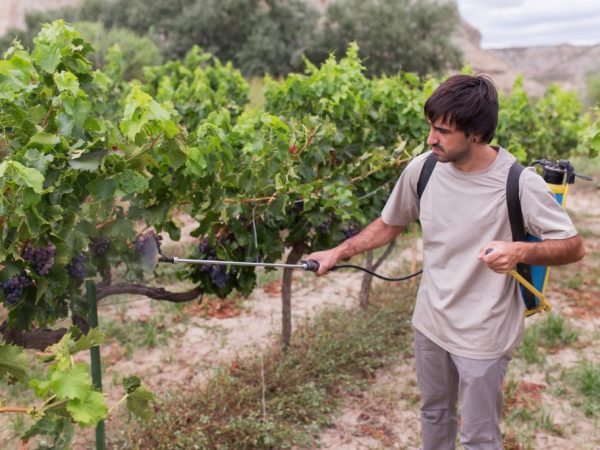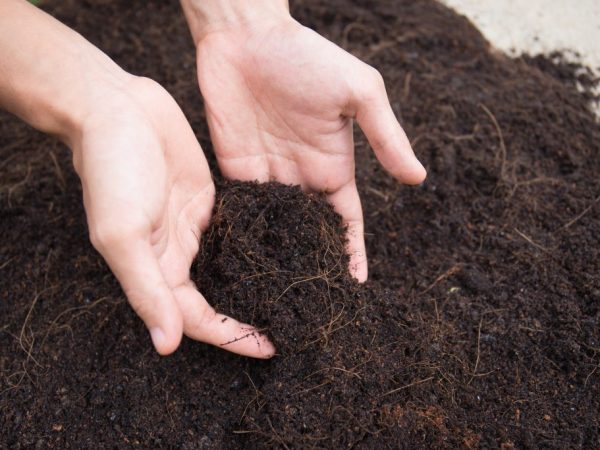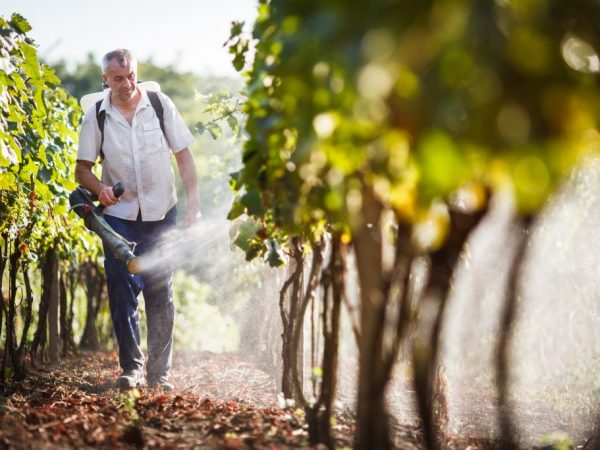Correct feeding of grapes
Top dressing of grapes is a mandatory event that should be started 2-3 years after planting the vine. It can be root and foliar, promotes the rapid growth of bushes, increases the quality and quantity of the crop. Fertilizers are applied 4-5 times per season at different periods of vegetation and fruit ripening.

Correct feeding of grapes
Essential minerals
The vine is a capricious plant that needs care. One of the activities that farmers often ignore is the correct application of fertilizers. They consist of a number of trace elements necessary for the growth, ripening of berries, and protection against diseases.
Minerals needed by the vine:
- Nitrogen. It stimulates the growth of stems and leaves, increases the green mass of the bush. Nitrogen fertilizers are beneficial for grapes in spring and early summer. In autumn, they cannot be brought in, since the vine will weaken and freeze in winter.
- Phosphorus. It promotes the formation of flowers and fruits, makes the berries tasty, and accelerates their ripening. It is recommended to apply it before the formation of inflorescences and 10-15 days before collecting the bunches.
- Potassium. It accelerates the ripening of the vine, making it more resistant to droughts, frosts, parasites and diseases. It is necessary to feed the bushes with potash mixtures in autumn and late summer in order to prepare the seedlings for wintering.
- Bor. It improves the germination of pollen, counteracts the dropping of the ovaries, accelerates the ripening of the bunches and makes them sweeter. Boron is introduced before the end of flowering or when the ovaries begin to form.
- Copper. It stimulates the development and growth of young shoots, increases frost resistance and drought resistance, improves immunity.
- Zinc. It increases yields.
- Magnesium. This element promotes better assimilation of phosphorus, takes part in the synthesis of proteins, and improves the taste of berries.
To obtain the entire set of minerals by the bushes, complex ready-made fertilizers for grapes and organic matter are introduced. It is also recommended to feed the vine with monopreparations. For example, urea, ammonium nitrate, monophosphate.
Types of mineral fertilizers
Ready-made fertilizers for grapes are bought in a store or prepared on their own.
It is recommended to feed the grapes with a complex preparation in the spring in order to add all the necessary mineral elements to the soil. The names of popular complex drugs:
- "Kemira";
- Plantafol;
- Florovit;
- "Solution".
Some farmers prefer to prepare their own mixes. Popular recipe for use in spring (for 10 liters of water):
- superphosphate - 20 g;
- ammonium nitrate - 10 g;
- potassium salt - 5 g.
The mixture is enough for one bush. Instead of superphosphate and nitrate, nitroammophoska is often used in a dose of 30 g. They are also replaced with azophoska in a similar amount.
Another useful recipe:
- potassium magnesium - 10 g;
- ammonium nitrate - 20 g;
- boric acid;
- water - 10 liters.
This dressing for grapes is used in the last spring days, when there is an intensive growth of the crown and branches. During the formation of ovaries, the bushes are watered with superphosphate, and in the fall - with potash fertilizers.
In autumn, it is advised to use the following mineral complex:
- potassium salt - 10 g;
- superphosphate granules - 20 g;
- boric acid - 1 g;
- zinc sulfate - 2 g;
- manganese sulfate - 2 g;
- potassium iodide - 1 g.
Dilute a mixture of salts in 10 liters of water. This is the dose for 1 bush.
Organic fertilizers

Humus is prepared in the fall.
Organic fertilizers for grapes contain all the necessary substances. They contain potassium, calcium and magnesium salts, nitrogen and many other elements. These substances are absorbed better than from artificial mineral complexes.
Too large doses of organic matter cannot be added either. In sandy soil, this is done once a year, in loamy soil - once every 2 years, and in black soil - once every 3-4 years.
From organic dressings for grapes are used:
- humus;
- compost;
- mullein;
- manure;
- chicken droppings;
- ash.
Humus is rotted manure mixed with plant debris and soil. It is prepared in the fall to be brought under the bushes in the spring. Compost is harvested in special pits for a long time. Leftovers of food products, grass and weeds, chicken droppings, manure are put there. In terms of composition, it is no less valuable than other organic fertilizers.
Dung and mullein should not be used fresh. It is advisable that they overwhelm. If there is no time to wait, use the following recipe:
- 2 kg of mullein are bred in 5 liters of water;
- let it brew for 3-4 days;
- the resulting infusion is diluted with water so that the final volume is 12 liters;
- used for watering 1 bush.
Poultry droppings are prepared in a similar way. A simple recipe for 1 bush:
- mix 1 part of droppings and 4 parts of water;
- insist 3-7 days;
- 1 liter of the prepared solution is diluted in 10 liters of water.
In autumn, the following complex is used (per 1 m²):
- rotted dry or liquid manure - 2 kg;
- bird manure - 1 kg / l of water;
- wood ash - 300 g / 10 l, one bush.
Wood ash is a rich source of calcium and other minerals. It is used as a top dressing for grapes 3-4 years after planting. Ash cannot be mixed with nitrogen and fresh manure. Also, it is not recommended to use it on alkaline soils. For land cultivation, 100-200 g of ash per 1 m² are used. To prepare a liquid mixture, the same amount is dissolved in 10 liters of water and insisted for 2-3 days. Used for watering 1 bush.
In the summer, yeast feeding is useful. They prepare it like this:
- 1 g dry yeast;
- 1 liter of water;
- 5 g sugar.
The mixture is allowed to brew for an hour, then diluted in 5 liters of water. The agent with yeast improves the absorption of microelements, accelerates the growth of bunches, and is useful for the development of the vine.
Fertilization schedule and rules
Determining what to fertilize your grapes with is just the first step. It is useful to know how to deposit funds correctly and on what schedule.
Top dressing rules

Foliar dressing will saturate the leaves with microelements
Root feeding of mature grapes is carried out according to certain rules. You cannot water the bush near the trunk. It is recommended to dig a small circular groove. The size of the circle depends on the age of the vine. For a young plant - 40 cm, for an old one - 70-80 cm. The depth of the groove should be about 25 cm for a young plant and 35-50 cm for an old one.
In the spring, the vine is fed with liquid complexes. In the fall, both liquid and dry products are introduced. Previously, the bush is watered with 4-5 liters of water, since minerals and organic matter in high concentration will damage the roots.
Fertilization schedule
Fertilization and feeding of any grapes should take place within certain periods of its growing season. It is recommended to do this 4-5 times during the season. Some farmers determine the time in folk ways, according to the phases of the moon. It is better to focus on the periods of plant development. Optimal schedule:
- Early spring, before the vine opens.In this case, the air temperature should be about 16 ° C.
- In May or June, before flowering itself.
- In the period when flowering ends or the first berries begin to form.
- 10-15 days before harvesting the bunches, around August.
- In late autumn, after leaf fall and before sheltering the vine for the winter.
The first feeding of grapes is carried out with superphosphate, ammonium nitrate and potash fertilizers. Instead of nitrate, you can use urea, urea. Combined nitrophosphate or azophosphate replaces both nitrate and superphosphate. They also use complex mineral fertilizers, slurry from manure, diluted with liquid in a ratio of 1:10. The event helps the vine to recover from the winter and begin intensive development.
The second top dressing for grapes is aimed at stimulating flowering. At this time, solutions of mullein or chicken droppings with the addition of boric acid are introduced. It is also allowed to reuse mixtures with superphosphate and nitrogen, urea, nitrophos, ready-made mineral complexes. The main components of the third feeding are nitrogen and magnesium. Kalimagnesia, ammonium nitrate, and other nitrogen fertilizers for grape vines, stimulating vegetation, are introduced.
For the fourth procedure, you will need potash and phosphorus combined fertilizers for grapes, nitrogen is not added. It is recommended to feed the vine with superphosphate and chlorine-free potassium salt. Take 20 g of each component, dilute in 10 liters of liquid. The mixture is designed for watering one bush.
After harvesting, the grapes are fertilized with either potassium, humate, or organic matter. Complex organic fertilizers are used only if they were not used in the spring. It is advised to feed the vine in this way every 2-3 years. Potash fertilizers will always be useful for grapes, they increase frost resistance. Also during this period, magnesium is introduced, which increases disease resistance.
Foliar dressing
The vine feeds not only through the roots, many substances enter it through the leaves. This is the reason why foliar feeding of grapes is also shown in the summer. At the same time, mixtures of all useful microelements are used, the preparations "Aquarin", "Plantafol", "Kemira", "Florovit", "Novofet". Chelate complexes, containing all the necessary elements in small doses, have proven themselves well.
The vine is also fed with folk remedies. Wood ash (200 g / l) is infused for 2-3 days. Then it is mixed with a decoction of herbs. It is recommended to add a mixture of minerals to an infusion of garlic or tobacco, solutions with copper sulfate or iron, used to fight fungi and parasites.
How and when foliar feeding is carried out
It is necessary to do foliar dressing of grapes according to a certain scheme 4 times a year:
- The bushes are treated for the first time 3-5 days before the flowers open. A mixture of boric acid with fungicides or iron is used to prevent disease and to stimulate berry formation. It is also advised to feed the vine with nitrogenous means.
- The second time the treatment is carried out 5-10 days after the beginning of flowering. Compositions with phosphorus or ash are used, nitrogen is excluded.
- The third time the vine is treated in July, 2 weeks after the second, with a similar composition.
- The last foliar feeding is carried out 15 days before the final ripening of the berries. Potash and complex potash-phosphorus fertilizers are used for grapes. With their help, they accelerate the ripening of berries, improve their taste, and prepare the vine for winter.
Use only liquid products. They are poured into a spray bottle, the lower surface of the leaves is irrigated. It is there that the stomata are located through which minerals penetrate into the plant. If there is no sprayer, moisten a cloth in the solution and gently wipe the lower surface of the sheet. It is recommended to apply fertilizer for grapes to the leaves in the early morning or evening, after sunset, otherwise the leaves will get burned.
Winegrowers' mistakes
If you carry out the correct feeding of the grape vine, it grows healthy, gives a good harvest. Unfortunately, many farmers make mistakes. As a result, not only the number of berries decreases, the bushes are also destroyed. The most common mistakes are:
- Top dressing only for young seedlings. A mature vine from 2-3 years old also needs additional minerals and organic matter. Young bushes receive all the necessary substances from the soil fertilized during planting.
- The use of complex products throughout the season. Such drugs should be introduced only in the spring. In summer and autumn, it is advised to feed the vine with separate microelements.
- Application of nitrogen in summer and autumn. Fertilizing with nitrogen for grapes is needed only at the beginning of the growing season. If it is late summer, the vine grows too strong and weakens before winter. As a result, the chance of its freezing in winter and infection by fungi increases.
- Surface application. This technique has several drawbacks. On the soil surface, nitrogen partially evaporates, potassium and phosphorus are more difficult to assimilate. Minerals penetrate only to the surface roots, they begin to grow more intensively than the deep ones. As a result, the bush loses its ability to receive nutrients and water from the deep layers of the soil, in winter the upper roots freeze out.
- Overdose. As a result of such actions, it is easy to get a burn of the roots and leaves, too intensive growth of the green part of the plant to the detriment of the development of bunches.
Summarizing
Fertilizing the vine according to the rules is easy, even for beginners. The study of the material will not take much time. The main thing is to follow the calendar, choose high-quality preparations, then the cultivation of the vine will turn into a pleasure, bring results and material benefits.


